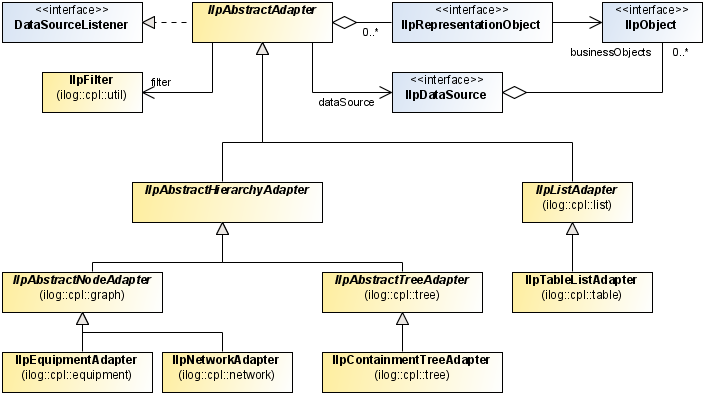The adapter is an object that acts like a bridge between a data
source and a graphic component. It converts the business objects of
the data source ( IlpObject instances), which are
component-independent, to representation objects which are suitable
for a given representation model, that is, for a given graphic
component. For information about the representation model and
representation objects, see The representation model.
The use of adapters is optional as you can
directly instantiate and insert representation objects into a
representation model. However, they are highly recommended as they
hide the complexity of creating representation objects
relationships. Using adapters, you do not need to care about
representation objects. All you have to do is create the business
model in the data source and customize the view and objects using
CSS to obtain an attractive graphic representation.
By default, adapters are meant to work in conjunction with a data
source. By default, they are used in all JViews TGO graphic
components.
Adapters also handle synchronization.
JViews TGO supplies
four kinds of adapter, each corresponding to a specific type of
representation model:
- The table adapter creates representation objects of type table row. See section Table component for the specific features of the table adapter.
- The tree adapter creates representation objects of type tree node. See section Tree component for the specific features of the tree adapter.
- The network adapter creates representation objects of type network node and link. See section Network component for the specific features of the network adapter.
- The equipment adapter creates representation objects of type equipment node. See section Equipment component for the specific features of the equipment adapter.
These adapters are all based on an abstract adapter, defined by the
interface IlpAbstractAdapter.
The following figure shows interfaces that
are directly related to adapters.

Adapter interfaces
This diagram shows that an adapter knows a data source. The adapter
listens to the data source, which notifies it whenever a new IlpObject instance is created. Once a new
object is added to the data source, the adapter creates the
corresponding IlpRepresentationObject instance if the
adapter configuration allows it.
In some cases, adapters can also contain temporary representation
objects that are created independently of the corresponding
business object (before it is created and retrieved from the data
source). These temporary objects are stored in the adapter along
with a means to determine whether the corresponding business object
has been created. For more information, see Creating
a temporary representation object.
All adapters support filtering of business objects. When a filter
is set to an adapter, only IlpObject instances in the data source that
satisfy specified conditions are represented in the representation
model. This filter is defined by the interface IlpFilter. For more information, see the
information on each graphic component.